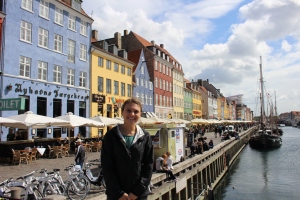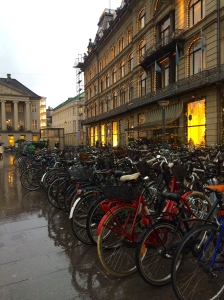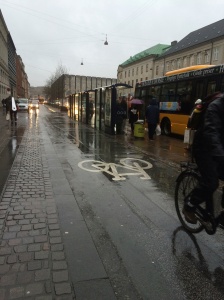KK Back in the USA

Hello, OEP followers! After a semester abroad in Copenhagen, Denmark, the European Green Capital of 2014, I am ecstatic to say I am back in Husky territory and ready to share the global environmental knowledge I have accumulated over the last four months. My travels through the UK, Germany, Sweden, and Denmark have shown me a vast range of environmental policy and practices present in Europe, pros and cons associated with different approaches taken towards energy and waste management problems, innovative ideas for incorporating environmentalism in education and across cultures, and much more. Over the next few months, I will be writing a series of blog posts explaining the most significant experiences I had with sustainability while overseas, so be sure to be on the look out!

To kick off the series, I figured what better a topic to start with than the city that is nearest and dearest to my heart: wonderful, wonderful København.
A Green Nation’s Best Friend
In Copenhagen, they are everywhere. Sitting snugly in designated train cars, whizzing past traffic jams and slow-moving pedestrians, accessorizing every available lamppost or railing, these masses of metal and rubber have an undeniable presence in Danish society. Each day, everyone from bright-eyed toddlers to silver-haired seniors, from daily commuters to the Crown Prince, Frederik, hop on these emission-free vehicles with ease, powering through whatever treacherous Scandinavian weather is thrown at them to get to their final destination. What is this magical environmental speed demon? The classic, reliable, bicycle!
So why do Danes love their bikes?

As environmentalists, I am sure many of us would like to say the appeal of an emission-free transportation method is the driving force behind the Danish bike trend. Surprising enough, however, only 1% of Danes surveyed sited environmental reasoning as their major motive for daily pedaling. 61% of responders said they bike because it is “convenient, fast, and easy,” 19% named exercise as their motivator, and 6% said financial reasons made biking ideal (Van Deurs, C.).
These percentages are not meant to be discouraging. Regardless of reasoning, it is an amazing fact that 18% of all trips in Denmark are made via bicycles. These sort of statistics should motivate the critical thinkers within us, bringing questions to the surface like “how did the Danish government create such a user-friendly bike system?” as well as, “what do we need to do to replicate such a system in other major cities, like New York or Boston, or non-urban environments like Storrs, for example?” If this avid biking culture could be transferred to other areas of heavy automobile use, imagine the environmental benefits that would arise!
Making a Bike System “Convenient, Fast, and Easy”

Creating a convenient bike system is no easy feat. Walking around Copenhagen and experiencing the bike life firsthand, it seemed every aspect of bike travel was thought out down to the most minor details. After careful observation and evaluation, here is a list of the top concepts that have made biking so popular in modern Denmark:
Accessibility: The network has an incredibly extensive presence, with an impressive 7,500 miles of bike lanes weaving throughout the country. This enables riders to travel to loads of desirable destinations both within in the city center and throughout the beautiful countryside.
Safety: Biker safety is key, and is enabled through clearly marked bike lanes, which are frequently separated from roadways by an actual physical barrier. Additionally, separate traffic lights for bikers assist users in properly understanding right of way, reducing unnecessary accidents.

Integration in Public Transportation: Need to take a cab, the Metro, or S-tog as part of your daily commute? Have no fear! Special train cars with bike racks make bike transportation a breeze. Elevators in metro stations reduce the need to carry bikes up and down the stairs. Taxi cabs carry attachments that allow travelers to lock their bike to the car and hop inside within minutes of the cab stopping.
The Little Things: Probably some of the most notable aspects of the Danish bike system that enable its success are small, practical solutions to problems of convenience. Bike racks are ubiquitous, which minimizes the time consuming anxiety of finding a place to park and promotes a quick commute. Metal ramps line the edges of staircases so users can push their bikes up and down stairs with little effort, rather than strenuously carrying the bikes. Ledges alongside the lanes allow an easy stopping process at traffic lights.
In addition to all of this, Denmark is a fairly flat country, which makes biking an easy task.

Food for Thought
The development of the Danish bike system has played a significant role in decreasing Copenhagen’s emissions and moving the city towards its commitment of carbon neutrality by 2025 (Copenhagen: CPH Climate Plan 2015). For the most part, however, the initiative was not motivated and pushed to fruition by environmental reasoning. Ultimately, it was the architectural planners’ constant, proactive thinking of human behavior and the ease with which users could ride their bikes that led to the immense integration of cycling into Danish culture.
To progress to a greener world, I believe we must continue to approach environmental problems with unique and creative mindsets. Successful policy and project implementation may not always lie in the environmental logic, but in the other underlying positive social motives.
Sources
Copenhagen: CPH Climate Plan 2025. (2014, January 1). Retrieved January 23, 2015, from http://cityclimateleadershipawards.com/copenhagen-cph-climate-plan-2025/
Cycling in Denmark. (n.d.). Retrieved January 23, 2015, from http://www.visitdenmark.co.uk/en-gb/denmark/nature/cycling-denmark
Van Deurs, C. (n.d.). Copenhagen Changing mindsets towards ‘Cities for People’. Retrieved January 23, 2015, from http://www.mobiliteit2050.be/gallery/multimedia/presentatiessprekers/camillapresentatie.pdf
Kerrin is a 6th semester Environmental Studies major and an undergraduate intern at the Office of Environmental Policy.
Great post Kerrin! Interesting to see how ubiquitous bikes are as public transportation in Denmark. Certainly not re phenomenon we see here in the U.S.
I’m curious – am I correct in assuming that most bikes there are privately owned? Or is there some some sort of rental or exchange program throughout the city? I wonder if having bikes available to borrow and then return of would incentivize even more people to use them.
I look forward to hearing the rest of your environmental takeaways from your trip.
Great work Kerrin!
Sounds like a great idea that UConn could endorse for off-campus students. But that leaves me with one great question – what do they do in the snow??
What a great analysis of the conditions that encourage biking! This is really really well done, Kerrin! The next step is figuring out which of these conditions can be replicated here.